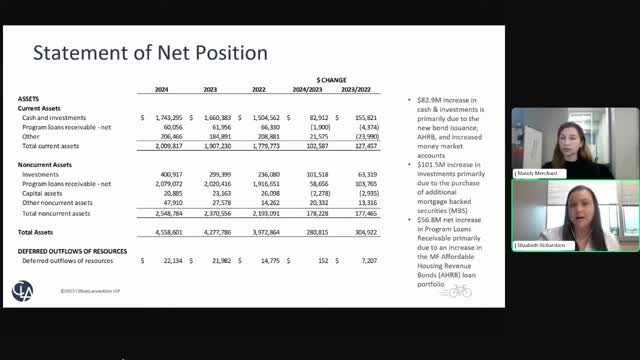CalHFA reports fiscal year 24 financial increases driven by affordable housing bonds
February 22, 2025 | Housing Finance Agency, Agencies under Office of the Governor, Executive, California
This article was created by AI summarizing key points discussed. AI makes mistakes, so for full details and context, please refer to the video of the full meeting. Please report any errors so we can fix them. Report an error »

The CalHFA Audit and Risk Committee convened on February 20, 2025, to review significant financial developments and their implications for the agency's operations. The meeting highlighted a notable increase in cash and investments, primarily driven by a new bond issuance under the affordable housing revenue bond indenture, which contributed to an $82.9 million rise in current cash and investments for fiscal year 2024. Additionally, the value of money market accounts also saw an uptick, reflecting a broader trend of increased liquidity.
The committee noted a substantial $101.5 million increase in non-current investments, largely attributed to the purchase of mortgage-backed securities. This strategic move indicates CalHFA's commitment to bolstering its investment portfolio amidst fluctuating market conditions. Furthermore, there was a $56.8 million net increase in program loans receivable, primarily from multifamily loans, underscoring the agency's focus on supporting affordable housing initiatives.
On the liabilities side, the committee reported a $53.2 million increase in loans payable, driven by an expanded line of credit and additional multifamily loans. The bonds payable also rose by $79.9 million, again linked to the recent bond issuance. However, there was a decrease in other non-current liabilities, reflecting a reduction in deferred revenue for specific programs.
The meeting also addressed changes in revenue streams, with a $36.5 million net increase in interest income due to favorable market rates. Conversely, loan fees decreased by $17.8 million, attributed to reduced activity in the single-family loan sector, which saw a 4% decline in loans. The committee expressed concern over a significant $125.5 million decrease in net transfers related to the SB 2 program and the moderate income program, highlighting the impact of declining real estate transactions on funding.
The discussions underscored the importance of monitoring these financial trends, particularly the decreasing SB 2 revenues, which are crucial for funding mixed-income housing initiatives. The committee plans to further explore these financial dynamics in upcoming meetings, emphasizing the need for a long-term financial strategy that aligns with the agency's mission to support affordable housing in California.
In conclusion, the CalHFA Audit and Risk Committee's meeting revealed critical insights into the agency's financial health and operational strategies. As the agency navigates a changing economic landscape, the focus will remain on leveraging financial resources to enhance housing affordability and stability in California.
The committee noted a substantial $101.5 million increase in non-current investments, largely attributed to the purchase of mortgage-backed securities. This strategic move indicates CalHFA's commitment to bolstering its investment portfolio amidst fluctuating market conditions. Furthermore, there was a $56.8 million net increase in program loans receivable, primarily from multifamily loans, underscoring the agency's focus on supporting affordable housing initiatives.
On the liabilities side, the committee reported a $53.2 million increase in loans payable, driven by an expanded line of credit and additional multifamily loans. The bonds payable also rose by $79.9 million, again linked to the recent bond issuance. However, there was a decrease in other non-current liabilities, reflecting a reduction in deferred revenue for specific programs.
The meeting also addressed changes in revenue streams, with a $36.5 million net increase in interest income due to favorable market rates. Conversely, loan fees decreased by $17.8 million, attributed to reduced activity in the single-family loan sector, which saw a 4% decline in loans. The committee expressed concern over a significant $125.5 million decrease in net transfers related to the SB 2 program and the moderate income program, highlighting the impact of declining real estate transactions on funding.
The discussions underscored the importance of monitoring these financial trends, particularly the decreasing SB 2 revenues, which are crucial for funding mixed-income housing initiatives. The committee plans to further explore these financial dynamics in upcoming meetings, emphasizing the need for a long-term financial strategy that aligns with the agency's mission to support affordable housing in California.
In conclusion, the CalHFA Audit and Risk Committee's meeting revealed critical insights into the agency's financial health and operational strategies. As the agency navigates a changing economic landscape, the focus will remain on leveraging financial resources to enhance housing affordability and stability in California.
View full meeting
This article is based on a recent meeting—watch the full video and explore the complete transcript for deeper insights into the discussion.
View full meeting
